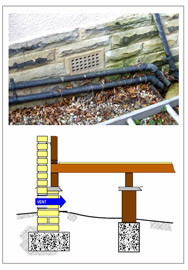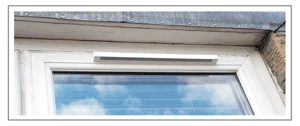
How you can reduce condensation and mould
What can you do to reduce or eliminate condensation and mould in your home?
Can you stop condensation on windows and walls ?
What causes condensation ?
Is it possible to stop condensation without spending a lot of money ?
Living with condensation and mould is at best an irritation, and many of our customers tell us that they feel it's affecting their health. So what measures can you take to improve things?
First things first. Are you sure your home really has a condensation problem ? Our Damp home diagnoser tool should point you in the right direction.
Homes that are warm and well ventilated don't suffer from condensation. So if you have a home that is:
... then you may find condensation is a problem.
What causes condensation and mold?
Condensation is caused by humid air inside your home that cannot escape to the outside. It is important to understand that it is not caused by damp outside that is trying to get in. Problems can occur from 'penetrating' dampness (water coming in from say leaking gutters or defects in the walls) but these are always confined to a single area in your home. If you have mould in different rooms in your home then you have a condensation problem.
The more people that live in a house then the higher the chances of condensation occurring. Likewise the smaller your home is, the higher the chance of condensation. So for example four people living in a three bedroom house are much more likely to have a condensation problem than one person living in the same sized house.
But the most important factor that affects condensation in the home is how 'air tight' your home is. In the race to make our homes ever more energy efficient we've been told that draughts are a bad thing. Most of us have draught proof doors and windows and we've sealed up the gaps in our homes. Add into the equation the increased number of showers and washing clothes more often, and the fact that children tend to spend longer in the home nowadays. So it's no surprise that air quality and condensation are a problem for many families.
Mold (or mould) will happily grow wherever there is sufficient condensation. And as condensation always starts in the cooler areas of your home where air does not circulate easily then this is where mold grows first.
In this guide we are going to avoid advice like "leave the windows open" or "don't dry clothes in-doors" as we recognise that these are simply not practical measures for many people. Leaving windows open will make your home cold and is a security risk. In winter many people have no option but to dry clothes inside.
However there are things you can do and changes that can help.
1. When possible leave internal doors open during the day
Allowing air to circulate around your home will help reduce condensation so it's a good idea to leave doors open (especially to the bedrooms) during the day.
2. At night sleep with bedroom doors open or ajar
Bedrooms are often the first place condensation occurs. Why ? because throughout the night we create humidity in bedrooms from breathing and perspiration - and this is the time when the temperature of the rooms falls to its lowest point. These are perfect conditions for condensation to form. And where condensation regularly forms then mould will follow sure as night follows day.
So leaving bedroom doors open or ajar overnight will help air to circulate and reduce condensation. This is particularly true where there are two people in the same room.
3. Leave wardrobe doors open
The worse room in the house to have a wardrobe is probably the master bedroom. The bedroom wardrobe is the perfect place to breed mould. It's usually full of clothes and the doors are shut. So it's cool with very little air circulation and it's in a room with one or two people providing a steady supply of humidity throughout the night.
So it's no wonder that one of the first signs of mould are when your clothes start to smell stale and foisty (but you may have become accustomed to the smell so it might be worth asking a friend for an honest opinion).
Keeping the wardrobe doors open all the time will help with that essential movement of air that's needed to avoid condensation. In fact you should think about where you store 'vulnerable' clothing (leather and suede attracts mould first). Maybe the wardrobe or the master bedroom are not the best place at all.
4. Shower in the morning & open the bathroom window !
Leaving windows open all the time can make your home draughty and cold, however it's a great idea to open the window when having a shower. The shower produces a huge amount of humidity which will then condense on the colder surfaces in your home. So opening the windows - and training your teenage children to do the same - will get rid of most of that humidity. Ideally windows should be left open for at least half an hour afterwards.
5. Check the operation of your bathroom fan
A simple check of the effectiveness of your bathroom fan is to hold your hand, or a piece of paper against it. You'll get a good feel for how much air it is drawing from the room.
We find that many fans are noisy but not at all effective. This may be because they are simply cheap and ineffective but we often see fans that are not installed correctly. Fans with long lengths of flexible ducting that snake through the loft are unlikely to work well. There is definitely a right and a wrong way of installing an extract fan.
6. Think about the best place for your tumble drier
Modern 'condensing' tumble driers seem to offer the convenience of an appliance that can be located anywhere in the home, and the effectiveness of a 'vented' drier (that is a drier that has an exhaust vent through the wall to the outside). Condensing tumble driers capture the humidity as water in a compartment that is then emptied.
Unfortunately we find that in reality a lot of humidity escapes condensing driers. So if you can, store your condensing drier in a room where the windows can be opened when it's in use, or even better store it in a garage or out-building if you have one.
7. If possible improve insulation
When installed correctly, cavity wall and loft insulation are very effective. Your home will be warmer and cheaper to heat.
However we often see homes with poor loft insulation - either too thin, or insulation that has been disrupted over the years.
Your loft should have around 250mm (10") of loft insulation. It is important that it is laid correctly - there should be no gaps in the insulation since this will lead to cold spots on the ceiling which will attract mould.
Loft insulation is a very worthwhile measure but if not installed correctly it can choke off the supply of fresh air to the loft which can cause the roof timbers to become damp.
8. Try to keep your home warm
Easier said than done, but keeping your home warm is an important part of the equation. Condensation seeks out the coldest surfaces in your home so keeping your home warm will help to reduce condensation and mould
9. Make sure the sub-floor vents around your home are clear

Most houses have timber floors with a gap between the floorboards and the ground. This sub-floor void should be ventilated. Over the years building regulations have become more stringent and the number of air bricks required around the base of an outside wall has increased. These air bricks allow air to pass under the floor and help keep the floor timbers dry. However we often see vents that are blocked, or are partially obscured by decking or a raised path.
A well ventilated sub-floor void (and for that matter a well ventilated loft) helps improve the 'health' of a house or bungalow. Houses that have concrete floors and therefore no ventilation beneath the floor are always more prone to condensation and mould.
10. If you have window trickle vents, keep them open.

We believe that the background movement of air in your home is essential for a healthy environment, and so having a gap under doors is important. This is particularly so for bedroom doors since the bedrooms are the major source of humidity in your home overnight and its overnight when temperatures fall and condensation becomes more likely.
11. Use the 'trickle' setting on Velux windows
In a similar vein Velux style windows have a trickle setting - by partially opening the top flap without actually opening the window. This adds a small but important source of air to the house especially as these types of windows are usually in the highest part of a room
12. Think about the impact home improvements may have on ventilation.
Last - and by no means least - is a checklist of changes to your home that may have unintended consequences.
Homes that have a problem with condensation today were probably fine when they were first built. It's the changes made over the years that bit by bit have caused the problems you have today.
If the decking covers air bricks at the base of a wall then make sure there are gaps to maintain the movement of air. Be very carefully when raising the level of a path. Will it breach the damp proof course ? Will it allow rain to splash against the walls above the damp proof course? It's good practice to install a narrow trench with pebbles or gravel in so that the path is not directly next to the wall.
High humidity + inadequate ventilation
= damp, condensation, mould

UK government advises:

